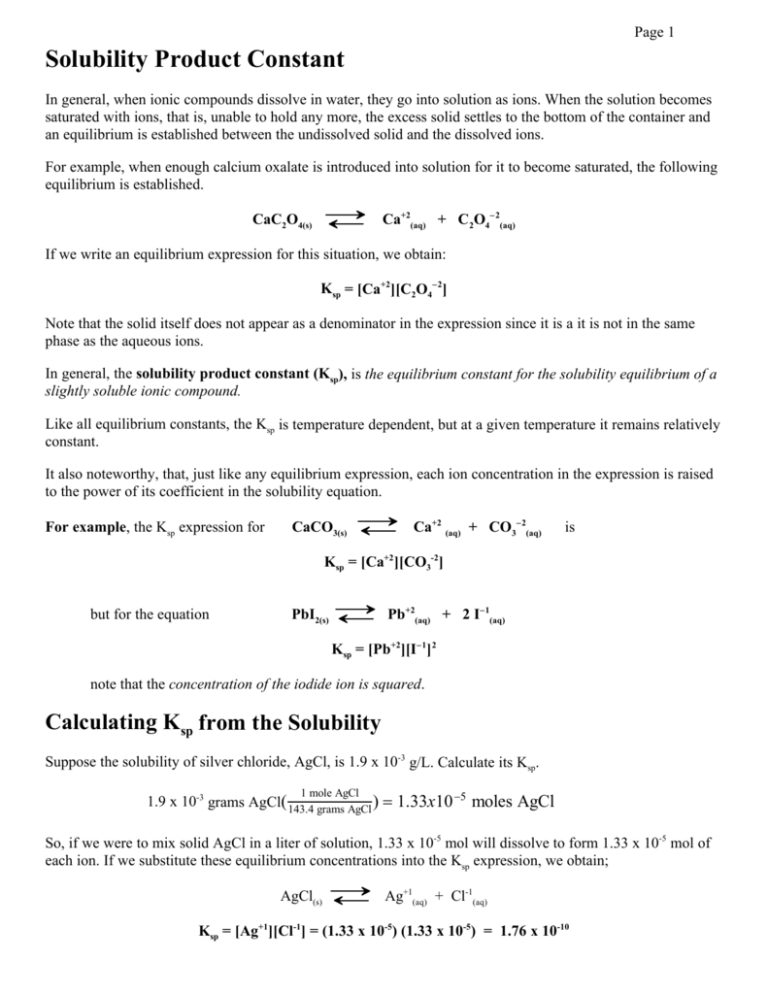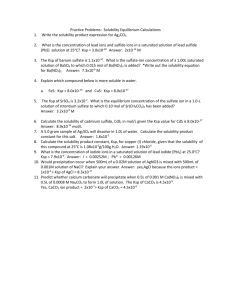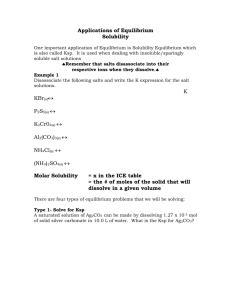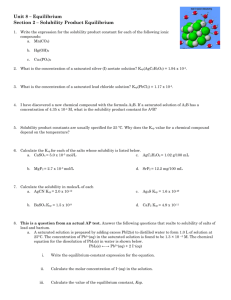Solubility Product Constant
advertisement

Page 1 Solubility Product Constant In general, when ionic compounds dissolve in water, they go into solution as ions. When the solution becomes saturated with ions, that is, unable to hold any more, the excess solid settles to the bottom of the container and an equilibrium is established between the undissolved solid and the dissolved ions. For example, when enough calcium oxalate is introduced into solution for it to become saturated, the following equilibrium is established. Ca+2(aq) + C2O4− 2(aq) CaC2O4(s) If we write an equilibrium expression for this situation, we obtain: Ksp = [Ca+2][C2O4− 2] Note that the solid itself does not appear as a denominator in the expression since it is a it is not in the same phase as the aqueous ions. In general, the solubility product constant (Ksp), is the equilibrium constant for the solubility equilibrium of a slightly soluble ionic compound. Like all equilibrium constants, the Ksp is temperature dependent, but at a given temperature it remains relatively constant. It also noteworthy, that, just like any equilibrium expression, each ion concentration in the expression is raised to the power of its coefficient in the solubility equation. For example, the Ksp expression for CaCO3(s) Ca+2 (aq) + CO3− 2(aq) is Ksp = [Ca+2][CO3-2] but for the equation Pb+2(aq) + 2 I− 1(aq) PbI2(s) Ksp = [Pb+2][I− 1]2 note that the concentration of the iodide ion is squared. Calculating Ksp from the Solubility Suppose the solubility of silver chloride, AgCl, is 1.9 x 10-3 g/L. Calculate its Ksp. 1.9 x 10-3 grams AgCl( 143.4 grams AgCl ) = 1.33x10 −5 moles AgCl 1 mole AgCl So, if we were to mix solid AgCl in a liter of solution, 1.33 x 10-5 mol will dissolve to form 1.33 x 10-5 mol of each ion. If we substitute these equilibrium concentrations into the Ksp expression, we obtain; AgCl(s) Ag+1(aq) + Cl-1(aq) Ksp = [Ag+1][Cl-1] = (1.33 x 10-5) (1.33 x 10-5) = 1.76 x 10-10 Page 2 A more complex problem is proposed when the salt we're dissolving contains more than multiples of a given ion.. For example The solubility of Lead(II)arsenate, Pb3(AsO4)2, is 3.0 x 10-5 g/L. Calculate its Ksp 3.0 x 10-5 grams Pb3(AsO4)2( 1 mole Pb(AsO 4 ) 2 899.44 grams ) = 3.34x10 −8 moles Pb(AsO 4 ) 2 In this case, however, the equation describing the dissolution of lead arsenate indicates that we obtain twice as many moles of the arsenate ion as we do lead ions. 3 Pb+2(aq) + 2 AsO4-3(aq) Pb3(AsO4)2(s) So, if we were to mix solid Pb3(AsO4)2 in a liter of solution, 3.34 x 10-8 mol will dissolve to form 3 x (3.34 x 10-8 ) mol of the lead ion, or 1.00 x 10-7 mol of Pb+2 and 2 x (3.34 x 10-8) mol of the arsenate, or 6.67 x 10−8 mol AsO4-3. In addition to tripling the number of moles of the lead ion and doubling the number of moles of the arsenate ion, you must remember that the lead ion concentration is cubed and the arsenate concentration is squared in the Ksp expression. If we substitute these equilibrium concentrations into the Ksp expression, we obtain; Ksp = [Pb+2]3[AsO4-3]2 = (1.00 x 10-7)3 (6.67 x 10− 8)2 = 4.45 x 10-36 Calculating Solubility from the Ksp Calculate the solubility in g/L of calcium sulfate, CaSO4, given that its Ksp is 2.4 x 10-5. The dissolution of calcium sulfate forms equal amounts of calcium ions and sulfate ions according to the following equation. CaSO4(s) Ca+2(aq) + SO4-2(aq) If we let [Ca+2] = [SO4-2] = x , then we can solve for the Molarity of calcium sulfate that would be soluble. Ksp = [Ca+2][SO4-2] 2.4 x 10-5 = (x)(x) solving for x we get [Ca+2] = [SO4-2] = 4.90 x 10-3 M Since the equation above shows a 1:1 mole ratio of calcium sulfate to Ca+2 ions, we can assume that 4.90 x 10-3 moles of CaSO4 will dissolve. Since CaSO4 has a mass of 136.1 g/mol, this would equate to: (4.90 x 10-3 mol/L) x (136.1 g/mol) = 6.67 x 10-1 grams/L Page 3 Solubility and the Common Ion Effect. In the event that we would try to dissolve a salt in a solution of another salt containing the same cation or anion, this common ion has a cumulative effect on the solubility equilibrium. For example, suppose we have a solution of Iron(II)sulfide. If we dissolve some sodium sulfide in the solution, the presence of the additional sulfide may cause the precipitation of FeS. The solution now contains less FeS. The decrease in the concentration of the FeS in a solution of Na2S is an example of the common ion effect. In general, any ionic equilibrium is affected by a substance producing an ion involved in the equilibrium. Calculating the solubility of a Slightly Soluble Salt in a Solution of a Common Ion (a) Calculate the molar solubility of barium fluoride, BaF2, in water at 25oC. The Ksp at 25oC is 1.0 x 10-6. BaF2(s) Ba+2(aq) + 2 F-1(aq) "x" "2x" (at equilibrium) Ksp = [Ba+2][F-1]2 1.0 x 10-6 = (x) (2x)2 = 4x3 solving for x, we get: x = 6.30 x 10-3 M Since "x" represents the molarity of the Ba+2 ion, and we get one mole of barium ions for each mole of barium fluoride that dissolves, we obtain a molar solubility for BaF2 of 6.30 x 10-3 M. Now, to illustrate the common ion effect. (b) What is the molar solubility of barium fluoride in a solution that is 0.15 M NaF at 25oC. Since the solution is already 0.15 M in F-1 ions, we must make an addition to our equilibrium concentrations. BaF2(s) Ba+2(aq) + 2 F-1(aq) "x" "2x + 0.15 " (at equilibrium) Ksp = [Ba+2][F-1]2 Because BaF2 is only slightly soluble, you might expect "2x" to be negligible compared to 0.15. In that case (2x + 0.15) ≅ (0.15) and substituting into the Ksp expression, we get 1.0 x 10-6 = (x) (0.15)2 solving for x, we get: x = 4.44 x 10-5 M Note that "x" is indeed much smaller than 0.15, so our assumption was correct. Therefore the molar solubility of barium fluoride in 0.15 M NaF is only 4.44 x 10-5 M. In pure water, the solubility is 6.3 x 10-3 M, which is over 140 times greater Page 4 Precipitation Calculations The Ksp for a salt can essentially tell you if precipitation will occur under conditions of ion concentration. If we have a given set of concentration conditions we can calculate a solubility quotient, Qc, and compare it to the Ksp. The solubility quotient (often called the ion product) has the same form as the solubility constant expression, but the concentrations of the substances are not necessarily equilibrium values. Rather, they are the concentrations at the start of the reaction. To predict the direction of the reaction, you compare Qc with Kc. If Qc < Kc, the reaction will go in the forward direction (the solution is unsaturated) If Qc = Kc, the reaction mixture is at equilibrium. If Qc > Kc, the reaction should go in the reverse direction (precipitation occurs) For example; Suppose a solution has Ca+2 and SO4−2 concentrations of 0.0052 M and 0.0041 M, respectively. If these concentrations were doubled by evaporating half the water in the solution, would precipitation of CaSO4 occur given that the Ksp for calcium sulfate is 2.4 x 10-5? Since the Ksp expression for calcium sulfate is Ksp = [Ca+2]equil[SO4-2]equil, then Qc = [Ca+2]init[SO4-2]init. Evaporating half of the water would double the initial concentrations of Ca+2 and SO4-2 to 0.0104 M and 0.0081 M, respectively. Substituting these initial conditions into the expression for Qc, we obtain Qc = (0.0104) (0.0082) = 8.53 x 10-5 Since this value for Qc is greater than the Ksp, you would expect precipitation to occur. Another example A solution of 0.00016 M lead(II)nitrate, Pb(NO3)2, was poured into 456 mL of 0.00023 M sodium sulfate, Na2SO4. Would a precipitate of lead(II)sulfate, PbSO4, be expected to form if 255 mL of the lead nitrate solution were added? (The Ksp for lead(II)sulfate is 1.7 x 10-8) First we must calculate the initial concentrations of Pb+2 and SO4-2 in the mixture. (0.00016 mol/L)(0.255 L) = 4.08 x 10-5 mol Pb+2 (from the 255 mL of Pb(NO3)2) (0.00023 mol/L)(0.456 L) =1.05 x 10-4 mol SO4-2 (from the 456 mL of Na2SO4) We must now divide each of these results by the cumulative volume of 255 mL + 456 mL = 711 mL [Pb+2] = 4.08 x 10 -5 mol Pb +2 0.711 L = 5.74x10 −5 M [SO4-2] = 1.05 x 10 −4 mol SO -2 4 0.711 L = 1.48x10 −4 M Substituting these initial concentrations into the Qc expression for PbSO4, we get; Qc = [Pb+2 ][SO4-2] = (5.74 x 10-5) (1.48 x 10-4) = 8.48 x 10-9 Since this value is less than the Ksp, we would not expect precipitation to occur Page 5 Completeness of Precipitation In the real world, the concentration of certain ions in drinking water or surface water can be determined by precipitating the ion of interest, filtering it out of the solution, and simply weighing the dried solid. In order for this to be an accurate analysis, we must be assured that most of the ion of interest was precipitated and very little remained in solution. For example, Lead chromate, PbCrO4, is a yellow pigment used in paints. Suppose 0.50 L of a 1.0 x 10-5 M Pb(C2H3O2) and 0.50 L of a 1.0 x 10-3 M K2CrO4 solution are mixed. Calculate the equilibrium concentration of Pb+2 ion remaining in the solution after PbCrO4 precipitates. What is the percentage of Pb+2 remaining in solution after the precipitation has occurred. (The Ksp for PbCrO4 is 1.8 x 10-14) First, let us assume a limiting reagent problem where all the lead chromate that is possible precipitates. Then using the Ksp, determine how much could redissolve. Pb+2(aq) initial 5 x 10-6 mol final 0 CrO4-2(aq) + PbCrO4(s) 5 x 10-4 mol -4 0 -6 5 x 10-4 mol (5 x 10 )- (5 x 10 ) = 4.95 x 10-4 mol The cumulative volume of the two solutions is now 1.0 L, so we now have 5 x 10-4 mol solid PbCrO4 in contact with a solution containing 4.95 x 10-4 M CrO4-2 ions. Let us now calculate how much of the solid lead chromate could possibly redissolve in the presence of this excess chromate ion. Pb+2(aq) PbCrO4(s) initial + CrO4-2(aq) 4.95 x 10-4 M 0 change +x +x equilibrium x 4.95 x 10-4 M + x Substituting into the Ksp expression for lead chromate, we obtain Ksp = [Pb+2][CrO4-2] 1.8 x 10-14 = (x)(x + 4.95 x 10-4) = (x)(4.95 x 10-4) .....assuming x is negligible compared to 4.95 x 10-4 Solving for "x" we get x= 1.8x10 −14 4.95x10 −4 = 3.64x10 −11 M Pb +2 remaining in solution The number of moles of Pb+2 in the solution prior to precipitation was 5.0 x 10-6 mol, so the percentage of Pb+2 remaining in the solution is: 3.64x10 −11 x100% 5.0x10 −6 = 7.3x10 −4 % and would generally be considered a complete precipitation. Page 6 Fractional Precipitation Fractional precipitation is the technique of separating two or more ions from a solution by adding a reactant that precipitates first one ion, then another, and so forth. For example, suppose a solution contains both Ba+2 ions and Sr+2 ions. As we slowly add a concentrated solution of potassium chromate, K2CrO4, to the solution, barium chromate precipitates first (since its Ksp is much less than that for strontium chromate). After most of the barium chromate has precipitated, strontium chromate begins to precipitate. It is therefore possible to separate Ba+2 ions from Sr+2 ions from a solution by fractional precipitation. Effect of PH on Solubility Suppose we wish to dissolve a salt whose cation or anion may undergo hydrolysis to form H+ or OH- in the solution. In this event, the pH of the solution may have a profound effect on the solubility of the salt. For example, consider the equilibrium between solid calcium fluoride and its ions in aqueous solution. CaF2(s) Ca+2(aq) + 2 F−1(aq) Because the fluoride ion is the conjugate bas of a weak acid (HF), you would expect it to react with any H+ ion that is added: F−1(aq) + H+(aq) HF(aq) According to LeChatelier's Principle, as F−1 ions are removed by the reaction with H+ ion, more calcium fluoride can dissolve to replenish the fluoride ions. Therefore you expect calcium fluoride to be more soluble in acidic solution than in pure water. In general, salts of weak acids should be expected to be more soluble in acidic solutions. For example, which salt would have its solubility more affected by changes in pH, silver chloride or silver cyanide? Looking at the two dissolution equations AgCl(s) Ag+(aq) + Cl-1(aq) AgCN(s) Ag+(aq) + CN-1(aq) we can assume that the chloride ion will not undergo hydrolysis since it is the conjugate base of the strong acid, HCl. However, the cyanide ion is the conjugate base of the weak acid, HCN, and consequently will react with any H+ ions present to reform HCN, thus removing cyanide ions from the solution. CN−1(aq) + H+(aq) HCN(aq) Based on this, one would assume that the solubility of the silver cyanide would be more affected by changes in pH. Page 7 Exam Review Topics terms skills/operations Solubility Product Constant Ion Product, Qc Fractional Precipitation Complex Ion Ligand Formation Constant, Kf Dissociation Constant, Kd Writing Solubility Product Expressions Calculating Ksp from Solubility Calculating Solubility from Ksp Calculating Solubility in presence of Common Ion Predicting Precipitation Determining Effect of pH on Solubility








